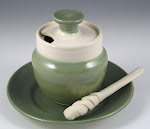I am not sure.
 |
| kitchen scale- indispensible |
The clay is Standard 213, a cone-6 porcelain. I have only tried porcelain a couple of times. Yes, porcelain is clay like stoneware and earthenware are clay, but it is made up of finer particles, and it will fire white. I'm surprised to find that it works great on the wheel. It stands up to throwing and behaves as asked. It doesn't live up to its reputation for throwing like soft cream cheese.
I am going to experiment with porcelain for weeks. I think the source of the forms is going to have to be play!
Before I started with 213, the wheel and tools and boards had to be washed in preparation. to prevent the porcelain being contaminated with chips and bits of darker clay.
 |
| cleanest my kickwheel has been in ages |
 |
| top view of tall saucers |
 |
| I had an idea- but the result isn't graceful |
So I went to 1-lb. 2-oz. balls of clay. I threw a more flaring sort of bowl, indented the sides, and funked up the feet. This clay dries FAST and can be altered and worked very soon after throwing.
So far, lots of fun.
But the next vases were a bit formal, because I didn't know what to make next and they are a sort of fall-back form.
 |
| They do actually stand upright. The camera distorts the angle. |
 |
| The first one is on the right. After that I decided to just loosen up. |
I closed my eyes and threw these blind. I knew I wanted lightness and roundness, and the rest was open. I sensed them. I just wanted to listen to Tedeschi and Trucks on the CD player and feel the clay move itself in my hands. When I opened my eyes, I gave each one just one more spiral in my hands, letting it find its own path. I didn't care at all about symmetry. These are the freest bowls I've thrown since maybe ever. I may or may not keep the one on the right- but it doesn't matter! They are more than bowls, they are experience combined with intuition and experimentation.
The source of these is certainly inside somewhere. I'm not going to analyze it, though. Not till I've made a lot of pots from this beautiful clay.







